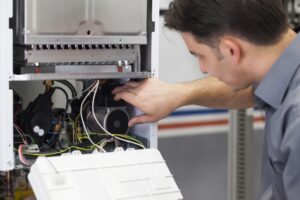One of the most obvious signals that a furnace is having trouble is when it makes a new or unexpected noise. But not all furnace problems are noisy. Without that audible alert to an issue, it’s harder to tell that something’s wrong. When a furnace has a silent problem, you’ll know that it’s time for repair if you spot one of these five warning signs.
1: Insufficient Heat
If you simply aren’t getting enough heat at all, even though the furnace continues to run, you’ve got a problem. If your furnace is electric, one of the heating elements may have stopped working. Since an electric furnace has at least three (and sometimes up to six) of these elements, you’ll still have some warmth, but not as much as you are accustomed to.
If your furnace is gas-burning, this problem can still happen, though the cause would be different. It could be from limited airflow, a misalignment of the burner, or even the thermostat needing to be recalibrated.
2: Uneven Heat
Sometimes, parts of a home stay nice and cozy while other parts just never seem to get quite warm enough. This could also be an airflow problem, but it could be a blockage or crimp in one section of ductwork. Making sure the air filter is clean is a good first port of call, but after that, get furnace service in Fresno, CA.
3: Non-Blue Pilot Flame
Natural gas burns blue. If the pilot light on your gas furnace is burning any other color, such as green, yellow, or orange, you have a serious problem. This could be from other gasses contaminating your natural gas, possibly from a breach in the line, or incomplete combustion, which can be a sign of a cracked heat exchanger. This is a serious hazard, so get help immediately.
4: Visible Problems
Take a look at your furnace from time to time and take note of what you see. Is there corrosion or rust on any of the surfaces? Is there a buildup of soot? Is water dripping from it? If you see any of these, or notice any changes or something else odd, play it safe and have it looked at by a qualified technician.
5: Short Cycling
Furnaces operate in cycles. They turn on when your home’s temperature gets a little too low, and they turn off when the temperature gets high again. While they’re off, the temperature slowly decreases until the thermostat signals for the furnace to come on again. These cycles should be ten or fifteen minutes long.
Short cycling is when the furnace shuts off shortly after beginning a heating cycle and then tries to start another cycle just moments later. It’s a symptom of a variety of possible problems. But it’s also a potential cause of many problems, including shortened system life and extremely high energy use, so whatever the root cause, it needs to be diagnosed and addressed promptly.
If you notice any of these signs, or have any questions about your heating system, please reach out. Whether it’s as simple as advice on changing air filters or as complex as choosing and installing a new system, we’re always happy to help.
We strive to provide honest answers and solutions to the problems our customers’ experience while remaining highly competitive in price, and offer the fastest turnaround you can find! Contact Donald P. Dick Air Conditioning to schedule service or sign up for Mr. Cool’s Super Saver Program.

